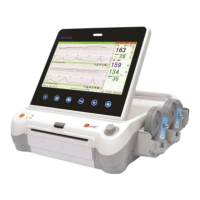S
S
S
R
R
R
F
F
F
6
6
6
1
1
1
8
8
8
B
B
B
6
6
6
U
U
U
s
s
s
e
e
e
r
r
r
’
’
’
s
s
s
M
M
M
a
a
a
n
n
n
u
u
u
a
a
a
l
l
l
~56~
Chapter 13 EMC Information
The device and its accessories, listed in the accessories section, comply with the following EMC standards:
• EN/IEC 60601-1-2: 2001+A1:2004
Take special precautions regarding electromagnetic compatibility (EMC) when using medical electrical
equipment. You must operate your monitoring equipment according to the EMC information provided in this
book. Before using the device, assess the electromagnetic compatibility of the device with surrounding
equipment.
CAUTION Although this is an electrical Class II device, it has a protective earth conductor which is needed
for EMC purposes.
Always use the supplied power cord with the three-prong plug to connect the monitor to AC mains.
Never adapt the three-prong plug from the power supply to fit a two-slot outlet.
CAUTION The use of accessories, transducers and cables other than those specified may result in increased
electromagnetic emissions or decreased electromagnetic immunity of the device.
WARNING Do NOT use cordless/mobile phones or any other portable RF communication system within the
patient vicinity, or within a 1.0 m radius of any part of the fetal monitoring system.
EMC Testing
CAUTION Fetal parameters, especially ultrasound, are sensitive measurements involving small signals, and
the monitoring equipment contains very sensitive high gain front-end amplifiers. Immunity levels for
radiated RF electromagnetic fields and conducted disturbances induced by RF fields are subject to
technological limitations. To ensure that external electromagnetic fields do not cause erroneous
measurements, it is recommended to avoid the use of electrically radiating equipment in close proximity to
these measurements.
Reducing Electromagnetic Interference
CAUTION The device should not be used adjacent to, or stacked with, other equipment unless otherwise
specified.
The product and associated accessories can be susceptible to interference from continuous, repetitive, power
line bursts, and other RF energy sources, even if the other equipment is compliant with EN 60601-1-2
emission requirements. Examples of other sources of RF interference are other medical electrical devices,
cellular products, information technology equipment, and radio/television transmissions.
When electromagnetic interference (EMI) is encountered, for example, if you can hear spurious noises on the
fetal monitor’s loudspeaker, attempt to locate the source. Assess the following:
Is the interference due to misplaced or poorly applied transducers? If so, re-apply transducers correctly
according to directions in this book or in the Instructions for Use accompanying the accessory.
Is the interference intermittent or constant?
Does the interference occur only in certain locations?
Does the interference occur only when in close proximity to certain medical electrical equipment?
Once the source is located, there are a number of things that can be done to mitigate the problem:
Eliminating the source. Turn off or move possible sources of EMI to reduce their strength.
Attenuating the coupling. If the coupling path is through the patient leads, the interference may be
reduced by moving and/or rearranging the leads. If the coupling is through the power cord, connecting
the system to a different circuit may help.

